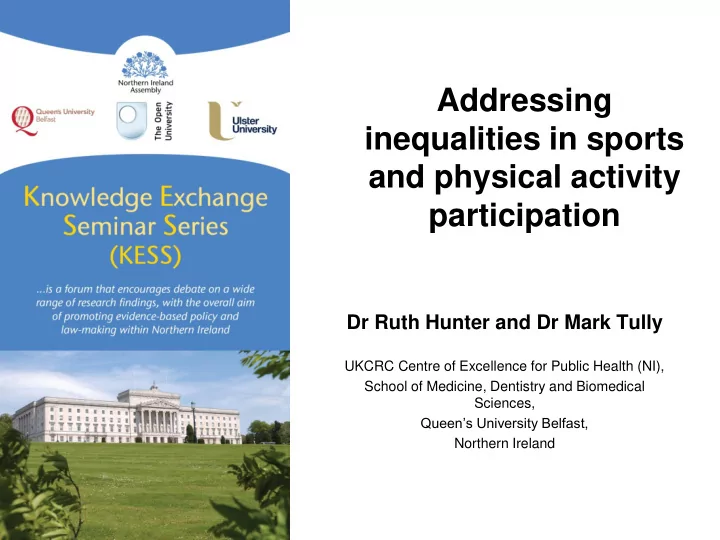

Addressing inequalities in sports and physical activity participation Dr Ruth Hunter and Dr Mark Tully UKCRC Centre of Excellence for Public Health (NI), School of Medicine, Dentistry and Biomedical Sciences, Queen’s University Belfast, Northern Ireland
Introduction DHSSPSNI, HSNI, 2013/14
Inequalities Gender Deprivation Age Disability “Currently failing to reduce the inequalities that exist in physical activity participation”
Knowledge of guidelines • 2011 Chief Medical Officer’s recommendations • Pre-requisite to influencing beliefs and social norms Hierarchy of Effects Model Attention Comprehension 8% Unaware Acceptance
Who is unaware? • Low level of education OR 5.91; 95% CI 1.67, 20.94) • Lived in more deprived areas OR 4.80; 95% CI 1.87, • Younger 12.30) OR 1.03; 95% CI 1.02, 1.05) • Low income OR 2.36; 95%CI 1.63, 3.41) • Reported poor health • Did no physical OR 2.71; 95% CI 1.61, activity 4.58) OR 2.74; 95% CI 1.31, 5.76)
Time for action • Clearly need for a health promotion campaign • Targeted = more effective • Enables targeting • Large reach • Real-time messages • Dynamic • Low cost
Physical Activity Participation • 53% not doing enough physical activity • Innovative and sustainable action • Considerable societal challenge • Limited resources • Target those ‘most in need’ Aim : Investigate characteristics of those doing: 1. No physical activity 2. Some physical activity 3. Sufficient physical activity
Modelling policy relevant stereotypes Most ‘in need’ • 55 years or older • Economically inactive • Poor health • No car • Poor health • Living in most deprived areas
Time for Action Requires a Shift
Older Adults Key factors in active travel: Neighbourhood deprivation Car ownership Disability/Health Urban dwelling More supportive environment
Disability Little is known about why people with long-standing illness/disability are less likely to participate in sport than others • Sample = 13,683 adults continuous household survey; 26% had a long-term illness/disability • Fewer of those with (24.5%), than without (55.6%), long-term illness reported sport participation in the previous year Need to target : • older people • married females • Rural dwelling • Socio-economically deprived • Report ‘not good’ health in last year
Conclusions Requires: • Physical inactivity – major • Change to government public health concern perceptions • Proven benefits • Cross-agency policies • Targeted efforts • Changes to built environment • Not “one size fits all” • Better public transport • • Active workplaces and schools Health promotion campaign • Older adults • Change in culture and mindset • Those with disabilities • Political endorsement • Multi-faceted strategies “Promote, support and facilitate change”
Summary Dr Ruth Hunter Lecturer, UKCRC Centre of Excellence for Public Health (NI) E-mail: ruth.hunter@qub.ac.uk Dr Mark Tully Lecturer, UKCRC Centre of Excellence for Public Health (NI) E-mail: m.tully@qub.ac.uk “Physical activity remains the best buy for public health”
Recommend
More recommend